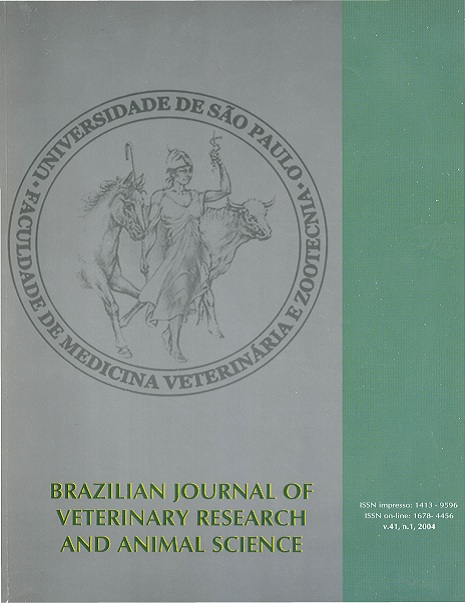Experimental ammonia poisoning in cattle fed extruded or prilled urea: clinical findings
DOI:
https://doi.org/10.1590/S1413-95962004000100010Keywords:
Urea, Ammonia poisoning, Clinical picture, CattleAbstract
Twelve yearling Girolando, rumen-fistulated steers never fed with urea before, were distributed randomly in 2 groups of 6 animals each. Both groups were administered intraruminally a single dose (0.5 g/kg BW) of extruded (G1) or prilled (G2) urea to induce ammonia poisoning. The clinical picture was followed for the next 240 min. Besides the classic signs the present study found 3 new additional sign: dehydration, hypothermia and ingurgitated episcleral veins. Convulsion, considered the definite sign, was seen in 5 out of 6 animals from both groups. One steer (G1) had only fasciculation, while another (G2) developed typical clinical signs, but not convulsion, and recovered spontaneously without treatment. The appearance of clinical signs such as muscle tremors, sternal recumbency and convulsive episode occurred at similar times in both groups, but when analyzed altogether they took place later in G1 (p < 0.04). The 1st sign to show up was fasciculation, followed by apathy, hyperaesthesia, pushing against obstacles, muscle tremor, rumen stasis, incoordination, sternal and then lateral recumbency, mild or severe dehydration, and convulsion. Higher heart rate was detected at the convulsive episodes. After the convulsions, 4 animals from each group had mild hypothermia. One steer from G2 fell down in coma and died suddenly before the beginning of the treatment. Although the extruded urea postponed the clinical picture, the signs were as severe as exhibited by cattle administered prilled urea. Both forms of urea offered at high dose can be harmful to cattle never fed urea.Downloads
Download data is not yet available.
Downloads
Published
2004-02-01
Issue
Section
UNDEFINIED
License
The journal content is authorized under the Creative Commons BY-NC-SA license (summary of the license: https://
How to Cite
1.
Antonelli AC, Mori CS, Soares PC, Kitamura SS, Ortolani EL. Experimental ammonia poisoning in cattle fed extruded or prilled urea: clinical findings. Braz. J. Vet. Res. Anim. Sci. [Internet]. 2004 Feb. 1 [cited 2024 Apr. 19];41(1):67-74. Available from: https://www.revistas.usp.br/bjvras/article/view/6259





